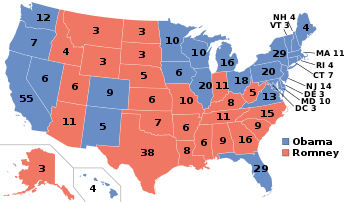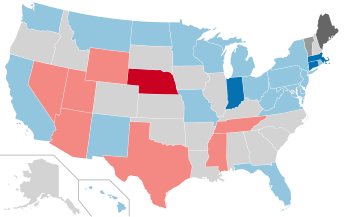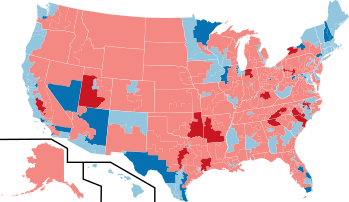| ← 2010 2011 2012 2013 2014 → Presidential election year | |
| Election day | November 6 |
|---|---|
| Incumbent president | Barack Obama (Democratic) |
| Next Congress | 113th |
| Presidential election | |
| Partisan control | Democratic hold |
| Popular vote margin | Democratic +3.9% |
| Electoral vote | |
| Barack Obama (D) | 332 |
| Mitt Romney (R) | 206 |
 | |
| Presidential election results map. Blue denotes states/districts won by Democrat Barack Obama, and Red denotes those won by Republican Mitt Romney. Numbers indicate electoral votes allotted to the winner of each state. | |
| Senate elections | |
| Overall control | Democratic hold |
| Seats contested | 33 of 100 seats |
| Net seat change | Democratic +2 |
 | |
| 2012 Senate election results map
Democratic hold Republican hold Independent hold Democratic gain Republican gain Independent gain | |
| House elections | |
| Overall control | Republican hold |
| Seats contested | All 435 seats |
| Popular vote margin | Democratic +1.2% |
| Net seat change | Democratic +8 |
 | |
| 2012 House election results map Democratic hold Republican hold Democratic gain Republican gain | |
| Gubernatorial elections | |
| Seats contested | 14 (12 states, 2 territories) (including a recall election in Wisconsin) |
| Net seat change | Republican +1 |
 | |
| 2012 gubernatorial election results map Democratic hold Republican gain Republican hold (including recall) Popular Democratic gain Nonpartisan | |
The 2012 United States elections took place on November 6, 2012. Democratic President Barack Obama won reelection to a second term and the Democrats gained seats in both chambers of Congress, retaining control of the Senate even though the Republican Party retained control of the House of Representatives. As of 2024, this is the most recent election cycle in which neither the presidency nor a chamber of Congress changed partisan control, and the last time that the party that won the presidency simultaneously gained seats in both the House of Representatives and the Senate.
Obama defeated Republican nominee Mitt Romney to win a second term, taking 51.1 percent of the popular vote and 332 of the 538 electoral votes. Romney defeated Rick Santorum, Newt Gingrich, and several other candidates to win his party's nomination in the 2012 Republican primaries.
Democrats won a net gain of two Senate seats, retaining control of the chamber. In the first election held in the House of Representatives since the round of redistricting following the 2010 United States census, Democrats picked up eight seats but failed to gain a majority, despite winning the popular vote. In the gubernatorial elections, Republicans won a net gain of one seat. This was the first time since 1936 that a Democratic presidential candidate who won a second term also had Senate coattails in both occasions (although Franklin Roosevelt won a third and fourth term in 1940 and 1944 respectively, he lost Senate seats on both occasions). This is the third straight presidential election where the winner had coattails in both houses of Congress.
Various other state, territorial, and local races and referendums were held throughout the year. Three state referendums passed legalizing same-sex marriage, while Minnesota became the first state in history to reject a proposed state-level constitutional ban of same sex marriage. Two states approved and one rejected the legalization of recreational marijuana, and one more state voted to legalize marijuana for medical use. A referendum was also held in Puerto Rico regarding the future political status of the U.S. unincorporated territory. Following the Supreme Court's Citizens United decision, the 2012 election season became the most expensive in American history.[1]
- ^ "Little to Show for Cash Flood by Big Donors". The New York Times. November 7, 2012.